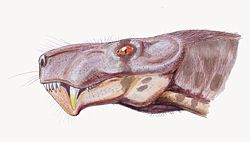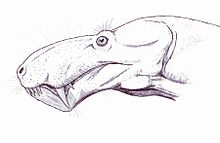- Gorgonops
-
Gorgonops
Temporal range: Late Permian (Wuchiapingian)
Head of G. torvus. Scientific classification Kingdom: Animalia Phylum: Chordata Class: Synapsida Order: Therapsida Suborder: †Gorgonopsia Family: †Gorgonopsidae Genus: †Gorgonops
Owen, 1876Gorgonops (literally "Gorgon' face") is an extinct genus of therapsid which lived about 255-250 million years ago, during the latest part of the Permian Period. It was a typical representative of the suborder Gorgonopsia, the dominant predators of their day, which in the largest forms grew to over four metres long. Gorgonops possessed highly developed, 12-cm long "sabre" canine teeth, similar to those found in sabre-toothed cats in the Cenozoic. Arguments have even been made for therapsids of its time being endothermic, though no strong evidence exists either way. All of the gorgonopsids are believed to have died out in the Permian extinction.
Gorgonops itself was a medium to large-sized representative of the group, with a skull length of twenty to thirty-five centimetres, depending on the species. It ranged from 2 to 2.5 metres long from nose to tail. Gorgonops derived superior speed from long legs held beneath its body.
The holotype of the type species, Gorgonops torvus, was in 1876 one of the first therapsids described, by Richard Owen, who also coined the name "Dinosauria" on the basis of the first known dinosaur fossils. It was also used as the type for which Richard Lydekker described the family in 1890. Five years later, in 1895, Harry Govier Seeley used this genus to establish the group as a whole. In later years, a large number of further species and genera were designated, but some of these turned out to be synonyms.
Contents
Species
The following list of species follows the list provided Sigogneau-Russell, 1989. The type species is listed first, then others in alphabetical order.
Since the publication of the work cited above, the dating of the Karoo Basin (Beaufort Group) has been revised. According to Smith and Keyser 1995, Gorgonops is known from the Tropidostoma and most of the Cistecephalus Assemblage Zones, and this has been taken into account when compiling the following list.
Gorgonops torvus (Owen, 1876) The type species. The holotype is an incomplete and flattened skull found at Mildenhalls, Fort Beaufort, South Africa. A number of other specimens have been found since, all from the Tropidostoma and/or Cistecephalus Assemblage Zone(s). This was a medium-sized therapsid, with a skull about twenty cm in length. It is distinguished from other species by a longer snout, and other details of the bones of the skull. Originally considered rather simple, it is actually (according to Sigogneau-Russell) a rather specialised member of the group.
Gorgonops longifrons (Haughton 1915) A large specimen known from an incomplete and flattened skull about thirty-five cm long. Orbit larger and snout longer than G. whaitsi, from which it may have descended. Beaufort West, Tropidostoma/Cistecephalus Assemblage Zone. Synonyms: Gorgonognathus longifrons Haughton 1915
Gorgonops whaitsi (Broom, 1912) Larger than G. torvus, with the rear of the skull wider, and other details of proportion. Originally the type species of Scymnognathus. Despite being known from a large number of specimens from the Karoo Basin, Beaufort West (Tropidostoma/Cistecephalus Assemblage Zone), the species remains poorly known. Watson and Romer placed Gorgonops and Scymnognathus in two different families, while Sigogneau-Russell 1989 placed the two species in the same genus, and considers G. whaitsi a more primitive (less derived) form. Synonyms: Scymnognathus whaitsi Broom, 1912
The following are more problematic species (either synonyms or uncertain placement):
Gorgonops? dixeyi (Haughton, 1926) A large, incomplete and flattened skull, from Chiweta Beds, Nyassaland. Placement uncertain. Probably Low Cistecephalus Assemblage Zone equivalent (= middle of the Wuchiapingian Stage). See Jacobs et al. 2005 for more on this species discussion on its age. Synonyms: Chiwetasaurus dixeyi Haughton, 1926
Gorgonops? kaiseri (Broili & Schroeder, 1934). A large (estimated total length about 35 cm long), incomplete skull, with a high snout and narrower in the rear than other species, from the "High Tapinocephalus zone" (i.e. earlier than the other species, most probably Pristerognathus Assemblage Zone) Synonyms: Pachyrhinos kaiseri Broili & Schroeder, 1934
Gorgonops? eupachygnathus (Watson, 1921) A flattened, incomplete, medium-sized skull, probably a juvenile of either G. torvus or G. whaitsi Synonyms: Scymnosuchus whaitsi Watson, 1921, Scymnognathus whaitsi (Watson, 1921), Leptotrachelus eupachygnathus WATSON, 1921, Leptotracheliscops eupachygnathus (Watson, 1921)
In popular culture
It was featured in Walking with Monsters as the top predator of the Permian, preying on Scutosaurus. In the series, it is simply referred to as "gorgonopsid," though, in the companion book, it is identified as "Gorgonops." It was highly unlikely that Gorgonops preyed on Scutosaurus, as the former lived in what is now South Africa, and the latter lived in what is now the Perm region of Russia. It was possible, however, that Gorgonops' European relatives, Inostrancevia and Sauroctonus, preyed on Scutosaurus.
It was also featured in the ITV sci-fi program Primeval, where one came through a time anomaly and stalked a local boy. Later another Gorgonops had fought and successfully killed a bat-like predator from the future.
See also
- List of synapsids
References
- Sigogneau-Russell, D., 1989, "Theriodontia I - Phthinosuchia, Biarmosuchia, Eotitanosuchia, Gorgonopsia" Part 17 B I, Encyclopedia of Paleoherpetology, Gutsav Fischer Verlag, Stuttgart and New York
- Jacobs, L. L., Winkler, D. A., Newman, K. D., Gomani, E. M. & Deino, A., 2005, Therapsids from the Permian Chiweta Beds and the age of the Karoo Supergroup in Malawi. Palaeontologia Electronica. Vol. 8, #1, pp. 28A: 21-23 online
- Smith, R.H.M. and Keyser, A.W. 1995. Biostratigraphy of the Tropidostoma Assemblage Zone. Geological Survey of South Africa, South African Committee for Stratigraphy, Biostratigraphic Series, 1:18-22.
Categories:- Gorgonopsia
- Prehistoric synapsids of Africa
Wikimedia Foundation. 2010.




